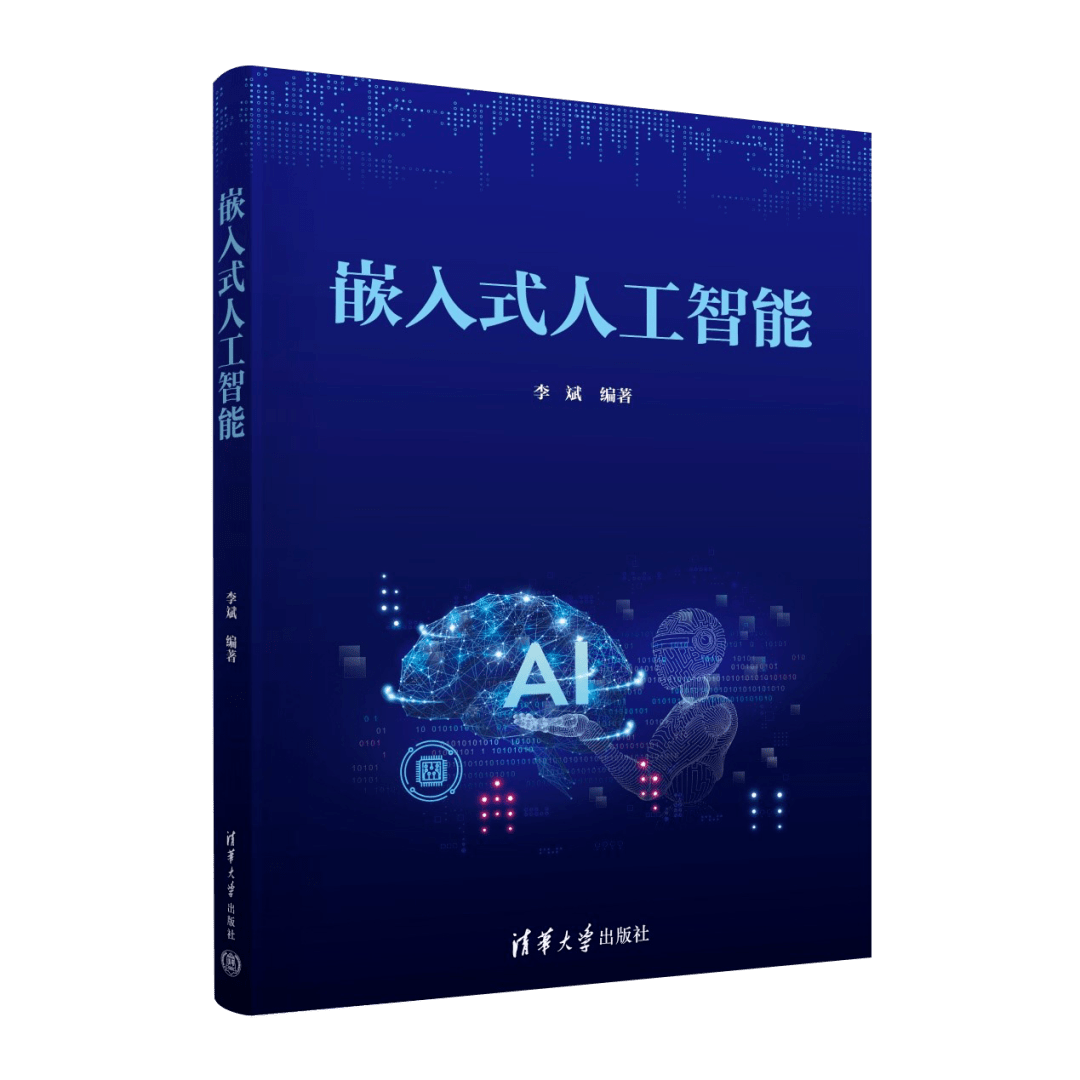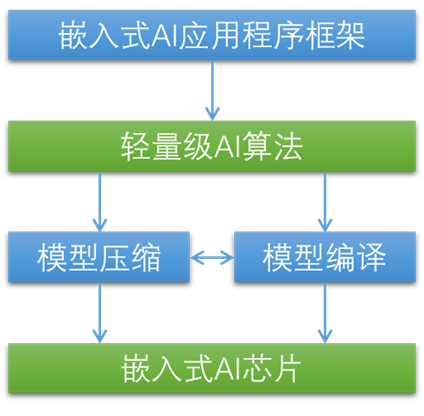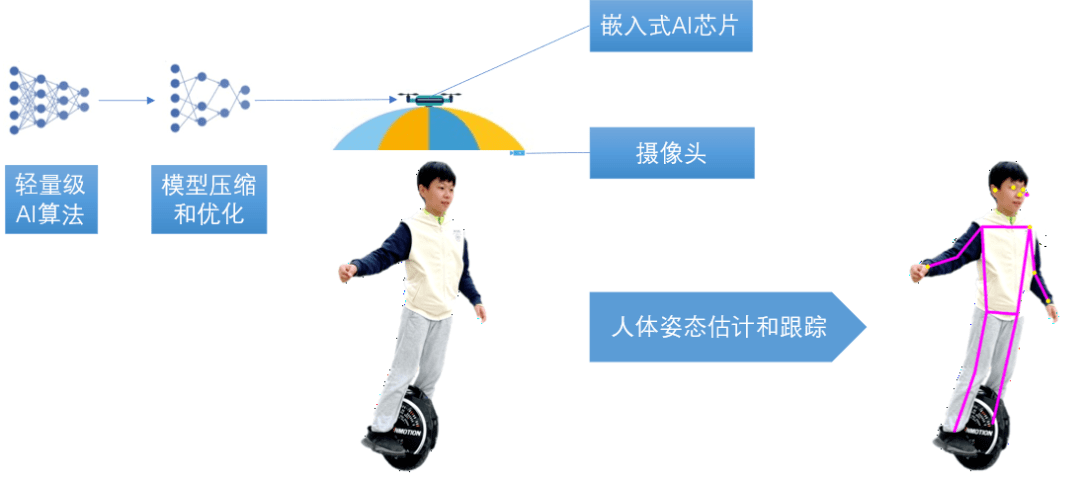New Book Recommendations | Embedded Artificial Intelligence

《Embedded Artificial Intelligence》
Compiled by Li Bin
ISBN:978-7-302-62796-8
Price: 69.00 yuan
Scan the QR code to purchase books with discount
The advent of ChatGPT has revealed the prototype of general artificial intelligence (AGI) to mankind. People have discovered that when artificial neural networks reach a certain scale, coupled with anthropomorphic learning methods (such as RLHF), miracles suddenly occur, and intelligence begins to get rid of the shackles of the human brain and is realized on computers!
However, there is still a challenge that needs to be solved: Can we achieve the above miracles on machines that are comparable in size and power consumption to humans, such as humanoid robots?
Currently, ChatGPT requires the use of more than 30,000 GPUs for training and inference, with a total power of more than 10 million watts and a daily electricity bill of approximately US$50,000. The volume of the human brain is only about 1.5 liters and the power is less than 20 watts. If we want to embed general artificial intelligence into robots, or even smaller drones, mobile phones, smart home appliances or IoT devices, we will have to overcome the above challenges. This is the topic that the book "Embedded Artificial Intelligence" wants to explore.
In the field of embedded artificial intelligence, we will use higher energy efficiency to execute more streamlined algorithms and place them in a machine with smaller size and weight to complete real-time reasoning tasks in the real world. . In a word, we must implement artificial intelligence in the most streamlined way!
To overcome this challenge, the problem needs to be addressed at all levels. To sum up, to realize embedded artificial intelligence, five components are needed.
Embedded AI chip. It is an AI accelerator with higher energy efficiency.
Lightweight AI algorithm. It has lower computational complexity and fewer parameters, but its accuracy is comparable to large AI algorithms.
Model compression. It further trims redundant parameters in lightweight AI algorithms and expresses them in a more streamlined way.
Compilation optimization. It translates the model into an encoding more suitable for the instructions of the AI accelerator.
Multi-level cascading application framework. It uses more appropriate algorithms at more appropriate times, thereby reducing overall system cost and energy consumption.

When these five components are used in combination, general artificial intelligence is expected to be truly embedded in the machine, allowing it to see, hear, speak, and think, and truly "live" and become another form of life. ——Artificial life.
Of course, there is a long way to go to realize the above dreams. This book is an introductory guide that explores the problems and outlines current methods and tools for solving them. It's not the final answer, but it provides the key to getting there.
If you are interested in realizing general artificial intelligence on robots, drones, mobile phones, smart home appliances, and Internet of Things devices, it is undoubtedly a useful introductory book.
Features of this book
1. Domestic The first comprehensive introduction to embedded artificial intelligence.
2. The content is rich and detailed, covering the principles, platforms and practices of embedded artificial intelligence.
3. Make a systematic summary of the principles of embedded artificial intelligence, the concept is novel and the organization is clear.
4. Comprehensive introduction to the implementation of embedded artificial intelligence platform, including mainstream embedded neural network chips and software frameworks.
5. Outline the development process of embedded artificial intelligence.
6. Combining principles with practice, combine code to demonstrate practical application cases of embedded artificial intelligence.
Application Example
In the last chapter of the book, we try to realize a flying sun umbrella based on a drone. This kind of umbrella can track people's movements in real time and block people from the sun at any time, thereby freeing people's hands and allowing you to enjoy the hot summer. You can happily go shopping, play, and become the focus of people's attention.
In order to enable unmanned parachutes to track human bodies, we will use machine vision methods. The human body is photographed by the camera on the front of the parachute, and the outline of the human body is calculated through a lightweight human posture estimation algorithm to obtain the positions of the person's head, facial features, and limb joints, and then analyze the movements of the human body to predict which direction the person will move forward. , retreat, turn or go up or downhill, so that the unmanned parachute can track this movement, adjust the spatial position of the unmanned parachute at any time, and achieve the following and sunshading effect on the human body.
Considering weight, power consumption and other reasons, a dedicated embedded AI chip must be used. In the book, NVIDIA Jetson is used as an example for development. Now, chips with stronger inference performance per watt, such as ARM-based SoCs, have been widely used to meet the challenges brought about by the rapid development of technology. But the processes and methods introduced in the book are still applicable.
In order for the above lightweight algorithm to meet the requirements of real-time reasoning on the embedded AI chip, it is necessary to use model compression and optimization technology to perform operations such as pruning and quantification on the model, reduce the parameters of the model, and allow reasoning Performance increases exponentially, power consumption decreases exponentially, and is optimized for dedicated embedded AI chip inference. The book uses TensorRT as an example to illustrate that if an ARM-based SoC is used, compression and optimization technologies such as Tensorflow Lite can be used.
Finally, with the help of the knowledge in this book, we can finally make the unmanned parasol fly!

Table of contents
Swipe up to read
Part 1 Principles
Chapter 1 Artificial Intelligence and Artificial Neural Network
1.1 What is artificial intelligence
1.2 What is artificial neural network
1.3 Human Brain
1.4 Basic composition of artificial neural network
1.4.1 Artificial Neuron
1.4.2 Structure of Artificial Neural Network
1.5 Learning mechanism of artificial neural network
1.6 Types of Artificial Neural Networks
1.7 Advantages of artificial neural networks
1.8 Deep Neural Network
1.8.1 What is a deep neural network
18.2 Common deep neural networks
1.8.3 Convolutional Neural Network
1.9 Neural Network Architecture Search (NAS)
1.9.1 Search space
1.9.2 Reinforcement Learning Search
1.9.3 Progressive Search
1.9.4 Discrete search
1.10 Transfer Learning
1.10.1 What is transfer learning
1.10.2 Types of transfer learning
1.10.3 Advantages of transfer learning
1.10.4 Transfer learning method
1.10.5 Transfer Learning and Embedded Artificial Intelligence
Chapter 2 Embedded Artificial Intelligence
2.1 What is embedded artificial intelligence
2.2 Why embedded artificial intelligence is needed
2.3 Initial attempt: cloud computing model
2.4 From cloud to device: local mode
2.5 Technical Challenges of Embedded Artificial Intelligence
2.5.1 Model scale
2.5.2 Energy efficiency
2.5.3 Memory access
2.5.4 Inference speed
2.5.5 Dimensions and weight
2.6 Implementation approaches of embedded artificial intelligence
2.7 Implementation components of embedded artificial intelligence
Chapter 3 Principles of Embedded AI Chips
3.1 Parallel Computing
3.2 Pulsating Array
3.3 Multi-level cache
3.4 Data flow
Chapter 4 Lightweight Neural Network
4.1 Reduce computational complexity
4.1.1 Grouped convolution
4.1.2 Depth direction convolution
4.1.3 Pointwise convolution
4.1.4 Depthwise separable convolution
4.1.5 Channel out-of-order mixing
4.2 SqueezeNet
4.2.1 Core Idea
4.2.2 Network structure
4.2.3 Performance
4.3 Xception
4.3.1 Core Idea
4.3.2 Network structure
4.3.3 Performance
4.4 MobileNet v1
4.4.1 Core Idea
4.4.2 Network structure
4.4.3 Performance
4.5 MobileNet v2
4.5.1 Core Idea
4.5.2 Network structure
4.5.3 Performance
4.6 MnasNet
4.6.1 Core Idea
4.6.2 Network structure
4.6.3 Performance
4.7 MobileNet v3
4.7.1 Core Idea
4.7.2 Network structure
4.7.3 Performance
4.6 Application of lightweight neural network
Chapter 5 Deep Neural Network Compression
5.1 General method of neural network compression
5.1.1 Pruning
5.1.2 Weight Sharing
5.1.3 Quantification
5.1.4 Binary/Ternary value
5.1.5 Winograd convolution
5.2 Compression-compilation co-design
5.2.1 The concept of compression and compilation co-design
5.2.2 Compressor
5.2.5 Compiler
5.2.6 Advantages of compression and compilation co-design
Chapter 6 Embedded Neural Network Application Framework
6.1 The composition of hierarchical cascading system
6.2 Efficiency of hierarchical cascading system
6.4 Local-cloud collaboration mode
Chapter 7 Lifelong Deep Learning
7.1 Defects and reasons of traditional deep learning
7.2 The goal of lifelong deep learning
7.3 Characteristics of lifelong deep learning
7.4 Neurobiological Implications
7.5 Implementation of lifelong deep neural network
7.5.1 Dual learning system
7.5.2 Real-time update
7.5.3 Memory merging
7.5.4 Adapt to real scenarios
7.6 Lifelong Deep Learning and Embedded Artificial Intelligence
Part 2 Platform
Chapter 8 Embedded Neural Network Hardware Accelerator
8.1 Overview
8.2 NVIDIA Jetson
8.2.1 Jetson module introduction
8.2.1 Jetson module internal structure
8.2.3 Jetson performance
8.3 Intel Movidius
8.3.1 Movidius Myriad X VPU chip
8.3.2 Intel Neural Compute Stick
8.4 Google Edge TPU
8.4.1 Introduction to Google Edge TPU
8.4.2 Working principle of Google Edge TPU
8.5 XILINX DPU
8.6 ARM Ethos NPU
8.6.1 ARM Machine Learning Processor
8.6.2 Ethos-N Series
8.6.3 Ethos-U Series
Summary
Chapter 9 Embedded Neural Network Software Framework
9.1 Tensorflow Lite
9.1.1 Introduction to TensoFlow Lite
9.1.2 How TensorFlow Lite works
9.2 TensorRT
9.3 OpenVINO
9.3.1 Introduction to OpenVINO
9.3.2 The composition of Open VINO
9.3.3 Open VINO application development
9.4 XILINX Vitis
9.5 uTensor
9.6 Apache TVM
Summary
Part 3 Realization
Chapter 10 Building an Embedded Neural Network Development Environment
10.1 Embedded AI development process
10.2 NVIDIA Jetson development process
Chapter 11 Optimizing Embedded Neural Network Model
11.1 TensorFlow model optimization
11.1.1 Post-training optimization
11.1.2 Optimization during training
11.2 TensorRT model optimization
11.2.1 Integrate with mainstream deep learning frameworks
11.2.2 Deployment to embedded systems
11.2.3 TensorRT API
11.2.4 TensorRT application example
11.2.5 Model Converter
11.3 Comparison of two model optimization techniques
Chapter 12 Performing Inference on Embedded Devices
12.1 Building the project from source
12.2 Use ImageNet to implement image classification
12.2.1 Static image classification
12.2.2 Camera real-time video classification
12.3 Use DetectNet to implement target detection
13.3.1 Static image target detection
13.3.2 Camera real-time video target detection
12.4 Using SegNet to implement semantic segmentation
12.4.1 Static image semantic segmentation
12.4.2 Video semantic segmentation
12.5 Using PyTorch to implement transfer learning
12.6 Using transformed models
Chapter 13 Embedded Neural Network Application Example
13.1 Application scenarios
13.2 Hardware selection
13.3 Model Development
Conclusion: Intelligence of all things
The above is the detailed content of New Book Recommendations | Embedded Artificial Intelligence. For more information, please follow other related articles on the PHP Chinese website!

Hot AI Tools

Undresser.AI Undress
AI-powered app for creating realistic nude photos

AI Clothes Remover
Online AI tool for removing clothes from photos.

Undress AI Tool
Undress images for free

Clothoff.io
AI clothes remover

Video Face Swap
Swap faces in any video effortlessly with our completely free AI face swap tool!

Hot Article

Hot Tools

Notepad++7.3.1
Easy-to-use and free code editor

SublimeText3 Chinese version
Chinese version, very easy to use

Zend Studio 13.0.1
Powerful PHP integrated development environment

Dreamweaver CS6
Visual web development tools

SublimeText3 Mac version
God-level code editing software (SublimeText3)

Hot Topics
 1387
1387
 52
52
 Top 5 GenAI Launches of February 2025: GPT-4.5, Grok-3 & More!
Mar 22, 2025 am 10:58 AM
Top 5 GenAI Launches of February 2025: GPT-4.5, Grok-3 & More!
Mar 22, 2025 am 10:58 AM
February 2025 has been yet another game-changing month for generative AI, bringing us some of the most anticipated model upgrades and groundbreaking new features. From xAI’s Grok 3 and Anthropic’s Claude 3.7 Sonnet, to OpenAI’s G
 How to Use YOLO v12 for Object Detection?
Mar 22, 2025 am 11:07 AM
How to Use YOLO v12 for Object Detection?
Mar 22, 2025 am 11:07 AM
YOLO (You Only Look Once) has been a leading real-time object detection framework, with each iteration improving upon the previous versions. The latest version YOLO v12 introduces advancements that significantly enhance accuracy
 Best AI Art Generators (Free & Paid) for Creative Projects
Apr 02, 2025 pm 06:10 PM
Best AI Art Generators (Free & Paid) for Creative Projects
Apr 02, 2025 pm 06:10 PM
The article reviews top AI art generators, discussing their features, suitability for creative projects, and value. It highlights Midjourney as the best value for professionals and recommends DALL-E 2 for high-quality, customizable art.
 Is ChatGPT 4 O available?
Mar 28, 2025 pm 05:29 PM
Is ChatGPT 4 O available?
Mar 28, 2025 pm 05:29 PM
ChatGPT 4 is currently available and widely used, demonstrating significant improvements in understanding context and generating coherent responses compared to its predecessors like ChatGPT 3.5. Future developments may include more personalized interactions and real-time data processing capabilities, further enhancing its potential for various applications.
 Best AI Chatbots Compared (ChatGPT, Gemini, Claude & More)
Apr 02, 2025 pm 06:09 PM
Best AI Chatbots Compared (ChatGPT, Gemini, Claude & More)
Apr 02, 2025 pm 06:09 PM
The article compares top AI chatbots like ChatGPT, Gemini, and Claude, focusing on their unique features, customization options, and performance in natural language processing and reliability.
 How to Use Mistral OCR for Your Next RAG Model
Mar 21, 2025 am 11:11 AM
How to Use Mistral OCR for Your Next RAG Model
Mar 21, 2025 am 11:11 AM
Mistral OCR: Revolutionizing Retrieval-Augmented Generation with Multimodal Document Understanding Retrieval-Augmented Generation (RAG) systems have significantly advanced AI capabilities, enabling access to vast data stores for more informed respons
 Top AI Writing Assistants to Boost Your Content Creation
Apr 02, 2025 pm 06:11 PM
Top AI Writing Assistants to Boost Your Content Creation
Apr 02, 2025 pm 06:11 PM
The article discusses top AI writing assistants like Grammarly, Jasper, Copy.ai, Writesonic, and Rytr, focusing on their unique features for content creation. It argues that Jasper excels in SEO optimization, while AI tools help maintain tone consist
 Getting Started With Meta Llama 3.2 - Analytics Vidhya
Apr 11, 2025 pm 12:04 PM
Getting Started With Meta Llama 3.2 - Analytics Vidhya
Apr 11, 2025 pm 12:04 PM
Meta's Llama 3.2: A Leap Forward in Multimodal and Mobile AI Meta recently unveiled Llama 3.2, a significant advancement in AI featuring powerful vision capabilities and lightweight text models optimized for mobile devices. Building on the success o




